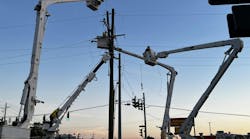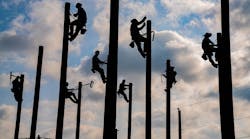Vegetation management crews in the Pacific Northwest often face two significant challenges: accessing remote structures and climbing gargantuan trees in dangerous conditions.
Bonneville Power Administration (BPA) maintains 15,000 miles of transmission lines by way of about 19,000 miles of access roads, but it can often take up to 45 minutes to reach a tower off the beaten path. Compounding the challenge, some of the Douglas-fir trees in need of side trimming can grow upward of 200 ft tall.
To make the tree-trimming process more efficient and safe for its contractors and linemen, BPA turned to other utilities to discuss their best practices regarding vegetation management. Through networking with other industry professionals, BPA's vegetation management team learned about aerial trimming.
Since 1985, utilities have used helicopters for aerial tree trimming as a method of controlling brush and trees encroaching on rights-of-way (ROW). This vegetation management technique is a cost-effective way of ensuring the reliability of transmission systems.
Because many utilities nationwide have already implemented aerial trimming, BPA turned to these companies to see just how many were using this technique. When the utility posed a question to the North American Transmission Forum, they learned that about 80% of the respondents were using aerial tree trimming as a technique to side trim trees along the ROW.
One of those companies is Commonwealth Edison (ComEd), which realized about a 40-to-1 improvement in productivity using this method in the Chicago area. Because Illinois typically has a flat terrain, smaller trees and easy access, BPA reasoned that it could get even greater efficiencies because of the hard-to-access remote structures in mountainous terrain and taller trees in the Pacific Northwest.
Researching the Program
BPA's vegetation management crews currently maintain the trees on the edge of the corridor by climbing them one at a time. When rough terrain limits the support of heavy equipment, the trimmers have to hike into these steep and awkward locations. This not only exposes crew members to higher risk, but it is also extremely time-consuming and expensive. BPA performs the majority of its side-trimming work this way. When BPA began considering the aerial-trimming method, the utility participated in internal safety reviews and conducted extensive research. Then, the utility's contracting office researched the potential bidders for the project. BPA's Aircraft Services division performed an analysis of the equipment and studied the background of the bidders.
At that point, Aircraft Services preapproved companies to bid on the work and then analyzed the bidders' operating, loading and safety records. The pilot project contract was awarded to Asplundh Tree Experts, which subcontracted the aerial-trimming work to Rotor Blade Airborne Vegetation Management.
It took about 18 months of in-depth analyses for BPA to move from conception to execution of the project. Once BPA selected the contractor, the company began setting up the project, establishing a schedule, and developing a job hazard analysis review. The BPA project manager Natural Resource Specialist Clayton Tinsley then notified land owners and met with Oregon state agencies to discuss the project schedule.
Putting the Plan into Action
To see whether aerial trimming was a viable vegetation management method for BPA, the utility conducted this pilot project. The utility contracted to have climbing crews to trim trees on the south side of an 8-mile stretch of line and then have a helicopter conduct aerial trimming on the north side of the same line.
Before performing the work, BPA identified any environmentally and culturally sensitive areas within the project boundary including threatened and endangered species habitat. The project area included land owned by the state of Oregon and a private timber company.
BPA posted signs in areas with logging to warn the loggers of the aerial crews activity along the ROW. The line crosses multiple logging roads, so the utility posted warning signs at the crossings to enhance the safety of the operation. BPA also evaluated the project area for any other conditions or concerns that the aerial and ground crews needed to be aware of, such as recreational activities.
BPA's contractor crews had to trim trees close to both lattice steel structures and wood poles. In many cases, the wood poles were supported with guy wires, so the contractors marked them with ribbons to protect the facilities and workers.
The pilot conducted a fly over of the project area to be worked, identified refueling sites and landing zones, and then returned to the airport to have the workers hook up the 10-blade saw to the helicopter. A ground support team also worked in communication with the pilot and BPA Transmission Line Maintenance Foreman III Paul Sever, who served as the clearance holder.
As a safety precaution, BPA took an outage on the 230-kV line coordinated with the time of the flight. While the line was out of service, BPA linemen also conducted a wood pole replacement project. This approach standard practice allows BPA to perform as much maintenance as possible during the limited duration lines are out of service.
The crews used a remotely operated, multi-blade saw and motor unit to trim Douglas-fir and alder trees along the edge of the ROW. BPA strived to avoid creating additional danger trees by not trimming the Douglas-fir below a 30% live crown ratio.
Clearing the Ground Area
BPA piloted this project as part of its integrated vegetation management program. The specific transmission line is maintained on a three-year maintenance cycle, which is based on growth characteristics of the tree species in the area. Trees often encroach from the side into the conductor areas.
Prior to the aerial trimming, a separate contractor came in to trim the south side of the corridor using the traditional climbing technique. This contractor enlisted a crew of five workers who drove and hiked the ROW, climbed the trees and took care of the understory brush on the floor of the corridor.
After the aerial trimming was completed, the ground support crew managed the debris created using the “cut, lop and scatter” method in which they cut the branches down into smaller chunks to reduce fire hazards.
Looking Ahead
Following the pilot project, BPA will compare three major factors between the climbing and aerial work: safety, quality and efficiency. For example, the aerial saw can clear the vegetation from ground to sky, while the climbing crews won't be able to climb to the top of the tree because it is less stable the closer they get to the top.
The aerial crew took three days to do the 8-mile stretch. By comparison, it took 15 days for a climbing crew to side limb the same project area.
As with any kind of field work, safety was also a concern. According to the National Transportation Safety Board, only four nonfatal accidents have occurred during aircraft operations for aerial tree trimming over the last 15 years.
BPA is considering doing this type of work with the conductors energized, like other utilities. For the pilot project, however, BPA decided to take an outage just to be safe.
If BPA is able to do the aerial trimming safely and cost-effectively, then the utility plans to expand it to other areas of the service territory. By relying on contractors and helicopter support, the utility hopes to maintain its ROW more efficiently and, at the same time, protect its field workforce.
Chuck Sheppard ([email protected]) is Bonneville Power Administration's manager of vegetation management, responsible for vegetation management and access road maintenance programs and supervising the natural resource specialists. Previously, he worked as the manager of vegetation management for ComEd, an Exelon Corp.
Editor's note: The live crown ratio of a tree is the percentage of the total tree height that has live branches. It represents the overall health and vigor of the tree, and can be used to understand the impacts of trimming.
Companies mentioned:
Asplundh Tree Expert Co. | www.asplundh.com
Bonneville Power Administration | www.bpa.gov
Rotor Blade Airborne Vegetation Management www.rotor-blade.com

